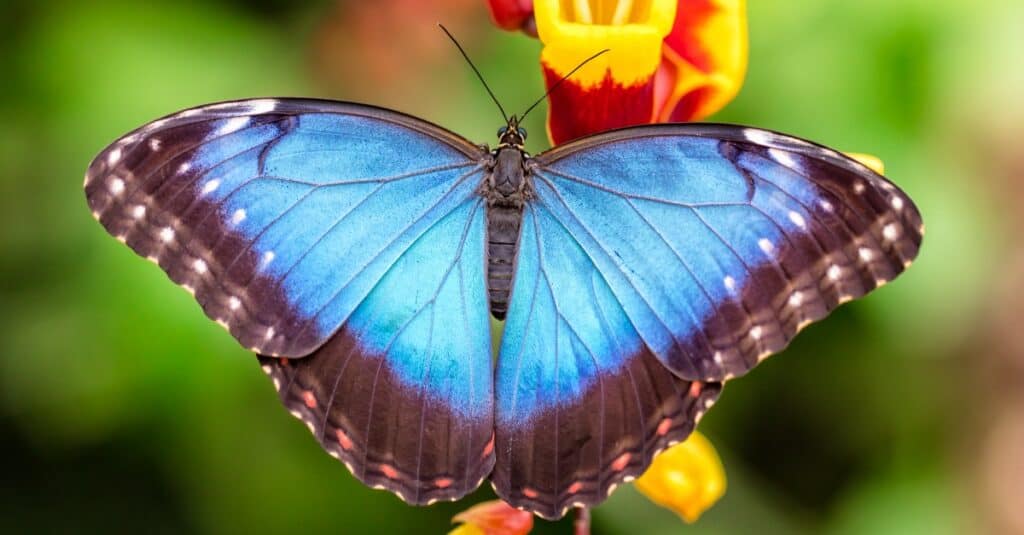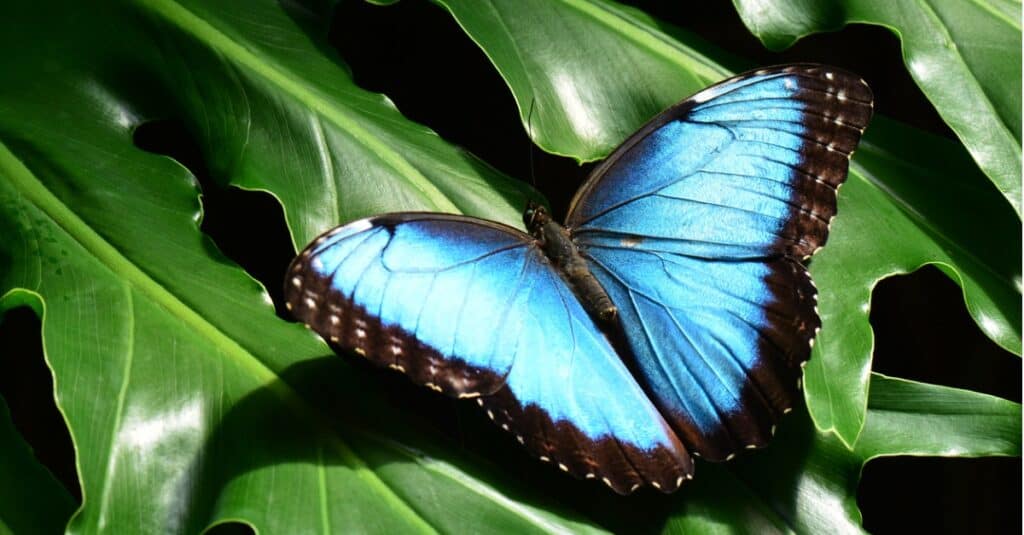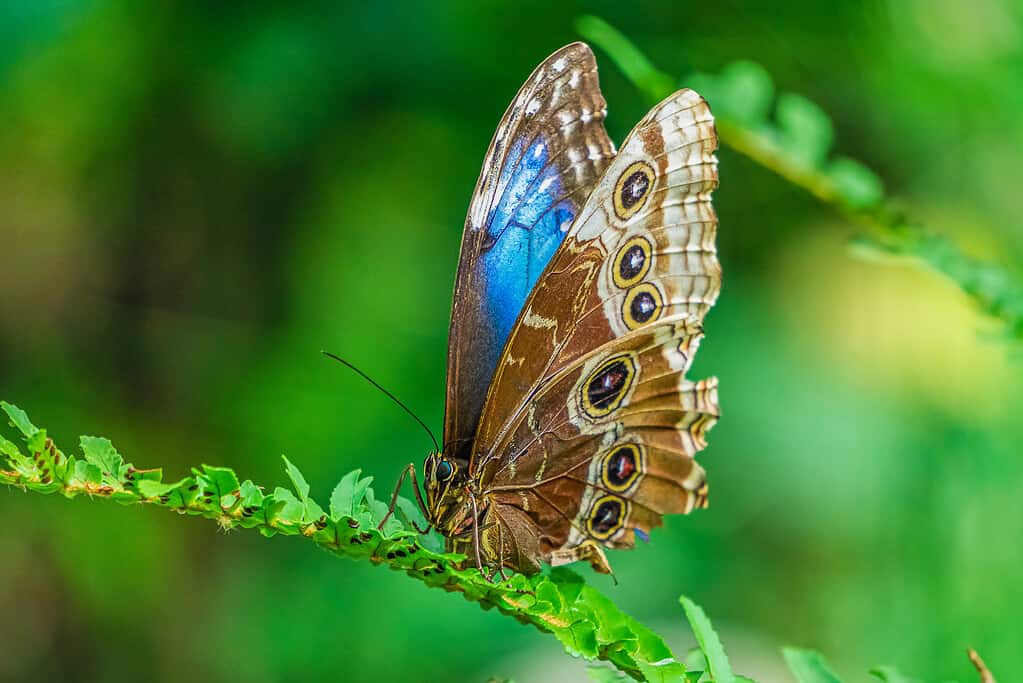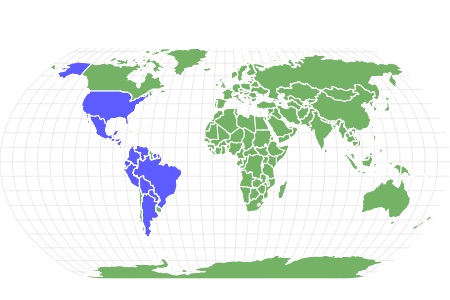Morpho Butterfly
Morpho butterflies have brightly colored, iridescent wings!
Advertisement
Morpho Butterfly Scientific Classification
Read our Complete Guide to Classification of Animals.
Morpho Butterfly Conservation Status
Morpho Butterfly Facts
- Name Of Young
- Caterpillar
- Group Behavior
- Solitary except during mating season
- Fun Fact
- Morpho butterflies have brightly colored, iridescent wings!
- Biggest Threat
- Habitat loss
- Most Distinctive Feature
- Brightly-colored wings
- Habitat
- Old-growth or secondary forests
- Predators
- Birds (especially jacamars and flycatchers), lizards, frogs, spiders
- Diet
- Herbivore
- Lifestyle
- Diurnal
- Favorite Food
- The juices of fallen fruit, tree sap, fungi, mud, and carrion
- Number Of Species
- 29
- Location
- Mexico, Central America, South America
- Slogan
- Collectors prize them for their bright wings
- Group
- Kaleidoscope
Morpho Butterfly Physical Characteristics
- Color
- Brown
- Yellow
- Blue
- Green
- Purple
- Multi-colored
- Skin Type
- Exoskeleton
- Lifespan
- Typically between 2-3 weeks
- Venomous
- No
- Aggression
- Medium
View all of the Morpho Butterfly images!
The term “morpho butterfly” applies to any of 29 species and numerous subspecies within the genus Morpho. They inhabit the Neotropical regions of Mexico, Central America, and South America. These insects are famous for their iridescent wings, which are usually blue in color. As adults, they feed by sipping the juices of various food sources like fallen fruit and carrion. Collectors often target them for their collections.
Morpho Butterfly Species, Types, and Scientific Name

butterflies are known for their iridescent wings, which are usually blue in color.
©Jag_cz/Shutterstock.com
Morpho butterflies are any of 29 species within the genus Morpho. In addition to this, the genus has numerous subspecies. The name Morpho comes from the Greek for “the shapely one.” The genus belongs to the family Nymphalidae (brush-footed butterflies), the order Lepidoptera (butterflies and moths), and the class Insecta (insects). As members of the phylum Arthropoda, these insects are invertebrates with exoskeletons.
List of Species and Subspecies
Below is a list of the 29 species and many of the subspecies of Morpho:
Morpho absoloni to Morpho hercules
- Morpho absoloni
- Morpho achilles
- Morpho achilles achilles
- Morpho achilles agamedes
- Morpho achilles fischeri
- Morpho achilles glaisi
- Morpho achilles guaraunos
- Morpho achilles patroclus
- Morpho achilles phokylides
- Morpho achilles vitrea
- Morpho aega
- Morpho aega aega
- Morpho aega amargosensis
- Morpho amphitryon
- Morpho amphitryon amphitryon
- Morpho amphitryon cinereus
- Morpho amphitryon susarion
- Morpho anaxibia
- Morpho athena
- Morpho aurora
- Morpho aurora aurora
- Morpho aurora aureola
- Morpho cisseis
- Morpho cisseis cisseis
- Morpho cisseis gahua
- Morpho cisseis phanodemus
- Morpho cypris
- Morpho cypris cypris
- Morpho cypris aphrodite
- Morpho cypris bugaba
- Morpho cypris chrysonicus
- Morpho cypris limonensis
- Morpho cypris ceibaensis
- Morpho deidamia
- Morpho deidamia deidamia
- Morpho deidamia diffusa
- Morpho deidamia diomedes
- Morpho deidamia electra
- Morpho deidamia granadensis
- Morpho deidamia guaraura
- Morpho deidamia hermione
- Morpho deidamia jacki
- Morpho deidamia lycanor
- Morpho deidamia neoptolemus
- Morpho deidamia polybaptus
- Morpho deidamia pyrrhus
- Morpho deidamia steinbachi
- Morpho epistrophus
- Morpho epistrophus epistrophus
- Morpho epistrophus argentinus
- Morpho epistrophus catenaria
- Morpho epistrophus titei
- Morpho eugenia
- Morpho hecuba
- Morpho hecuba hecuba
- Morpho hecuba obidonus
- Morpho hecuba polyidos
- Morpho hecuba werneri
- Morpho helenor
- Morpho helenor helenor
- Morpho helenor achillaena
- Morpho helenor achillides
- Morpho helenor anakreon
- Morpho helenor charapensis
- Morpho helenor coelestis
- Morpho helenor cortone
- Morpho helenor corydon
- Morpho helenor guerrerensis
- Morpho helenor insularis
- Morpho helenor leontius
- Morpho helenor macrophthalmus
- Morpho helenor maculata
- Morpho helenor marajoensis
- Morpho helenor marinita
- Morpho helenor montezuma
- Morpho helenor narcissus
- Morpho helenor octavia
- Morpho helenor packeri
- Morpho helenor papirius
- Morpho helenor peleides
- Morpho helenor peleus
- Morpho helenor pindarus
- Morpho helenor popilius
- Morpho helenor rugitaeniatus
- Morpho helenor telamon
- Morpho helenor theodorus
- Morpho helenor tucupita
- Morpho helenor ululina
- Morpho helenor violaceus
- Morpho helenor zonaras
- Morpho helenor prometa
- Morpho helenor coibaensis
- Morpho helenor caldarai
- Morpho hercules
- Morpho lympharis
- Morpho lympharis lympharis
- Morpho lympharis descimokoenigi
- Morpho lympharis eros
- Morpho lympharis stoffeli
Morpho marcus to Morpho zephyritis
- Morpho marcus
- Morpho marcus marcus
- Morpho marcus intermedia
- Morpho marcus major
- Morpho menelaus
- Morpho menelaus menelaus
- Morpho menelaus alexandrovna
- Morpho menelaus amathonte
- Morpho menelaus argentiferus
- Morpho menelaus assarpai
- Morpho menelaus coeruleus
- Morpho menelaus didius
- Morpho menelaus eberti
- Morpho menelaus godartii
- Morpho menelaus titogilberti
- Morpho menelaus julanthiscus
- Morpho menelaus kesselringi
- Morpho menelaus laurellae
- Morpho menelaus neildi
- Morpho menelaus occidentalus
- Morpho menelaus orinocensus
- Morpho menelaus terrestris
- Morpho menelaus verae
- Morpho menelaus zischkai
- Morpho niepelti
- Morpho polyphemus
- Morpho polyphemus polyphemus
- Morpho polyphemus catalina
- Morpho polyphemus luna
- Morpho portis
- Morpho portis portis
- Morpho portis thamyris
- Morpho rhetenor
- Morpho rhetenor rhetenor
- Morpho rhetenor cacica
- Morpho rhetenor columbianus
- Morpho rhetenor equatenor
- Morpho rhetenor hightoni
- Morpho rhetenor helena
- Morpho rhetenor subtusmurina
- Morpho rhodopteron
- Morpho richardus
- Morpho sulkowskyi
- Morpho sulkowskyi sulkowskyi
- Morpho sulkowskyi hoppiana
- Morpho sulkowskyi selenaris
- Morpho telemachus
- Morpho telemachus telemachus
- Morpho telemachus iphiclus
- Morpho telemachus ilianae
- Morpho theseus
- Morpho theseus theseus
- Morpho theseus claritae
- Morpho theseus heraldica
- Morpho theseus justitiae
- Morpho theseus juturna
- Morpho theseus oaxacensis
- Morpho theseus pacificus
- Morpho theseus perlmani
- Morpho theseus schweizeri
- Morpho theseus triangulifera
- Morpho theseus yaritanus
- Morpho theseus chirripoensis
- Morpho uraneis
- Morpho zephyritis
Appearance: How to Identify the Morpho Butterfly

The stunning color of these butterflies is due to microscopic ridges that reflect light in a way that creates the illusion of vibrant colors.
©iStock.com/SHAWSHANK61
Morpho butterflies are famous for their metallic, iridescent wing colors. Males are typically more vibrant than females, which are often brownish or yellowish. Although species like the blue morpho butterfly sport iconic blue wings, other potential hues include green and purple. The stunning coloration of these butterflies is due to microscopic ridges on their wing scales, which include glass scales and ground scales. These ridges reflect light in a way that creates the illusion of vibrant colors. This serves as a potential deterrent to predators, which may associate bright hues with toxicity.
The underside of the wings lacks these structures and therefore appears drab and brownish. This is essential to the butterflies’ ability to camouflage themselves when at rest. During nocturnal periods, they fold their wings together to expose the drab undersides.
Morpho butterflies are some of the largest in the world, particularly in terms of their wingspans. Because their wings are so big compared to their bodies, they often exhibit a strange bouncing effect when flying. Sizes range considerably from that of Morpho rhodopteron, whose wingspan averages three inches, to the massive sunset morpho (Morpho hecuba), whose wingspan measures up to eight inches.
Like most other members of Nymphalidae, morpho butterflies have shortened front legs, especially the males.
Habitat: Where to Find the Morpho Butterfly
Morpho butterflies are Neotropical butterflies inhabiting Mexico, Central America, and South America. Stray individuals have occasionally made their way into the state of Arizona in the United States, though it houses no breeding populations.
Morpho butterflies inhabit Amazonian and Atlantic old-growth forests, though they also breed in other types of forests like secondary forests and deciduous woodlands. These forests range from sea level to 4,600 feet. Some species rarely leave the treetops while others descend to the ground in search of fallen fruit, mud, and carrion. Males are territorial with the tendency to pursue rivals.
Below is a list of the countries, islands, and regions with species of morpho butterflies:
| North America (including Central America) | South America |
|---|---|
| Belize | Argentina |
| Costa Rica | Bolivia |
| El Salvador | Brazil |
| Guatemala | Colombia |
| Honduras | Ecuador |
| Mexico | French Guiana |
| Nicaragua | Paraguay |
| Panama | Peru |
| Trinidad | Suriname |
| United States (Arizona) | Venezuela |
The IUCN does not currently list any species of morpho butterflies on their Red List of Threatened Species. However, the blue morpho butterfly (Morpho peleides) is under threat from deforestation and habitat fragmentation.
Evolution and History

Morpho butterflies use their wings both as a warning to predators and as camouflage.
©Seda Yalova/Shutterstock.com
The order Lepidoptera, which comprises about 160,000 extant species of butterflies and moths, dates back to at least the Miocene Epoch (23.03 to 5.33 million years ago). The earliest fossils come from about 15 MYA during the Neogene Period, though some scientists speculate that some butterfly fossils may date as far back as 40 MYA.
The oldest of the Lepidoptera crown group appeared during the Carboniferous Period about 300 MYA. The proboscis emerged during the Middle Triassic Period at approximately 241 MYA. Later, during the Cretaceous Period about 98 MYA, butterflies developed diurnal tendencies. Their overall development coincided with that of angiosperms (flowering plants).
Today, morpho butterflies use their wings both as a warning to predators and as camouflage. Their bright coloration falsely advertises their nonexistent toxicity while the drab underside of their wings helps them blend into their environment.
Diet: What Do Morpho Butterflies Eat?

Morpho butterflies in the larval stage (caterpillars) eat the leaves of various plants.
©iStock.com/dschaef
Morpho butterflies are herbivores with the notable exception of the larval blue morpho butterfly. These insects also have a number of predators.
What Do Morpho Butterflies Eat?
Morpho butterflies in the larval stage (caterpillars) eat the leaves of various plants. Some of these plant species are toxic, rendering the caterpillars poisonous and therefore unsafe for consumption. Interestingly, the larvae of the blue morpho butterfly are cannibalistic, often feeding on their fellow caterpillars. As adults, morpho butterflies use their proboscises to sip the juices of fallen fruit, tree sap, fungi, mud, and carrion.
What Eats Morpho Butterflies?
The predators of morpho butterflies include birds, lizards, frogs, and spiders. Common predatory bird species include the jacamar and flycatcher. Though humans do not use morpho butterflies as a source of food, they often capture or breed them for inclusion in insect collections or for use in jewelry.
Related Animals:
View all 164 animals that start with MMorpho Butterfly FAQs (Frequently Asked Questions)
Are morpho butterflies dangerous?
Morpho butterflies are not dangerous to humans. However, the caterpillars ingest toxins from plants, which render them poisonous.
How many legs do morpho butterflies have?
Like all insects, morpho butterflies have six jointed legs. As members of Nymphalidae, they have shortened front legs unsuitable for walking.
How do you identify morpho butterflies?
The wings of morpho butterflies are typically an iridescent blue, though they may also be green or purple. They are large in size with wingspans ranging from three to eight inches. Their front legs are shorter than their other four legs.
Where are morpho butterflies found?
Morpho butterflies are found throughout Mexico, Central America, and South America. They also occasionally stray into the United States.
Are morpho butterflies endangered?
The IUCN does not currently include any morpho butterfly species on its Red List. However, there is evidence that the blue morpho butterfly is endangered due to habitat loss.
Thank you for reading! Have some feedback for us? Contact the AZ Animals editorial team.
Sources
- Rainforest Alliance, Available here: https://www.rainforest-alliance.org/species/blue-morpho-butterfly/
- Animal Corner, Available here: https://animalcorner.org/animals/morpho-butterfly/
- Britannica, Available here: https://www.britannica.com/animal/morpho-insect
- Bug Guide, Available here: https://bugguide.net/node/view/62011
- Butterflies of America, Available here: http://www.butterfliesofamerica.com/L/t/Morpho_a.htm
- Florida Museum, Available here: https://www.floridamuseum.ufl.edu/science/dna-tells-story-butterfly-evolution/
- Akito Y. Kawahara, David Plotkin, Marianne Espeland, Karen Meusemann, Emmanuel F. A. Toussaint, Alexander Donath, France Gimnich, Paul B. Frandsen, Andreas Zwick, Mario dos Reis, Jesse R. Barber, Ralph S. Peters, Shanlin Liu, Xin Zhou, Christoph Mayer, Lars Podsiadlowski, Caroline Storer, Jayne E. Yack, Bernhard Misof, and Jesse W. Breinholt, Phylogenomics reveals the evolutionary timing and pattern of butterflies and moths, Available here: https://www.pnas.org/doi/10.1073/pnas.1907847116

















